Hydrotherosaurus
Hydrotherosaurus (meaning "water beast lizard") is an extinct genus of elasmosaurid plesiosaur from the Upper Cretaceous (Maastrichtian stage) Moreno Formation of Fresno County, California, USA. The only known species, H. alexandrae, was named for its discoverer, Annie Montague Alexander, by Samuel Paul Welles.
| Hydrotherosaurus | |
|---|---|
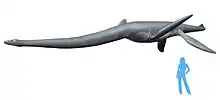 | |
| Restoration | |
| Scientific classification | |
| Kingdom: | Animalia |
| Phylum: | Chordata |
| Class: | Reptilia |
| Superorder: | †Sauropterygia |
| Order: | †Plesiosauria |
| Family: | †Elasmosauridae |
| Genus: | †Hydrotherosaurus Welles, 1943 |
| Species: | †H. alexandrae |
| Binomial name | |
| †Hydrotherosaurus alexandrae Welles, 1943 | |
Physiology
Hydrotherosaurus measured approximately 7.8 metres (26 ft) in length.[1] It has one of the longest necks relative to total length among elasmosaurids, with 60 vertebrae in total. It had a small head that measured about 33 centimetres (13 in; 1.08 ft) long, a streamlined body, and four large flippers that were specially designed to help the huge animal balance, move, and accelerate itself.
While it may be expected that Hydrotherosaurus was capable of consuming larger types of fish due to its size, evidence from fossil specimens show potential problems for its ability to catch and hold on to its slippery prey.
References
- O'Gorman, J.P. (2016). "A Small Body Sized Non-Aristonectine Elasmosaurid (Sauropterygia, Plesiosauria) from the Late Cretaceous of Patagonia with Comments on the Relationships of the Patagonian and Antarctic Elasmosaurids". Ameghiniana. 53 (3): 245–268. doi:10.5710/AMGH.29.11.2015.2928.
Sources
- Welles, S. P. (1943). "Elasmosaurid plesiosaurs with a description of the new material from California and Colorado". University of California Memoirs. 13: 125–254.
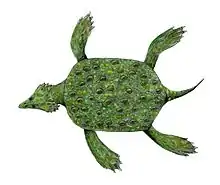
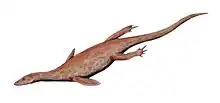
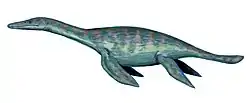

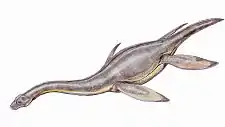
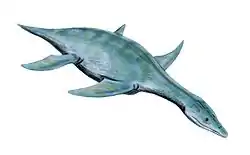
.png.webp)